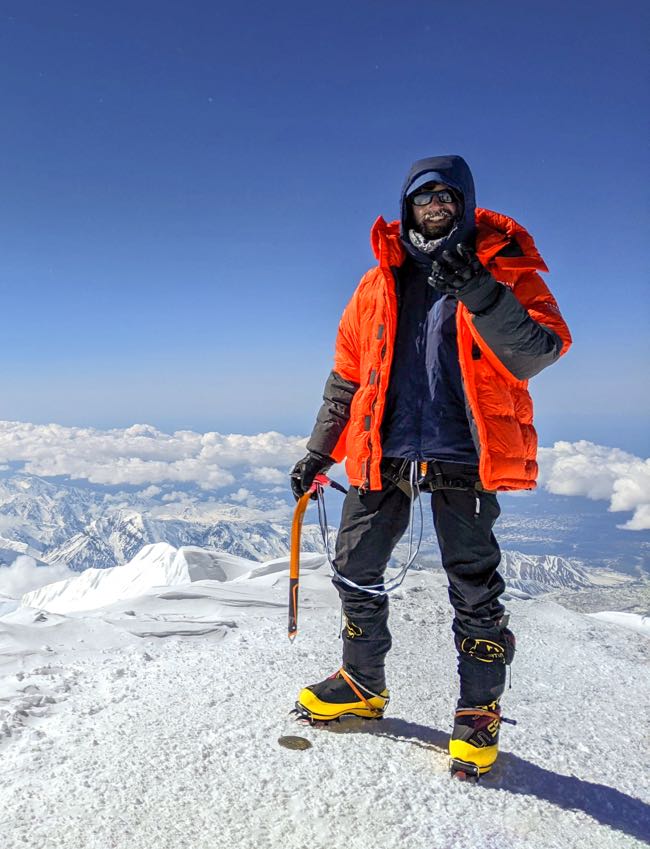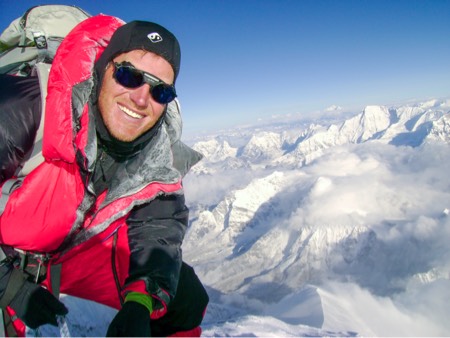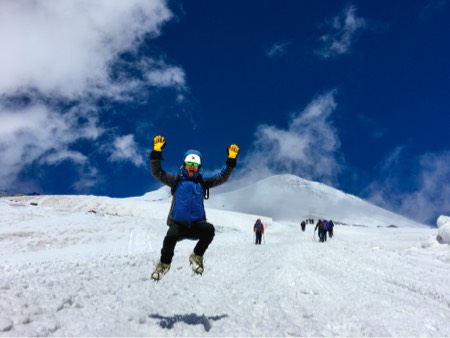Seven mountains

Andrew Dawson on the summit of Denali, the tallest mountain in North America, last year
Mountaineers, that is people who love the thrill of getting to the top and returning safely to earth, have their bucket-list peaks. There’s Everest, of course. And for a few, K2, slightly shorter than Everest but technically harder and thus deadlier. In Europe, the Matterhorn beckons, and in America, Rainier throws ice and storms but rewards with unforgettable Pacific Coast views.
Then there’s the seven summits, the tallest mountain on each continent. The first person to climb them all was Texas oil magnate Richard Bass in 1985. Asked why, Bass pointed to his business success: “If that’s all I was chasing, it would be an empty bauble of accomplishment. I know a lot of executives who wake up and say, ‘My God, there’s got to be more.’ ”
Bass was an amateur. But a year after his seventh peak, Reinhold Messner, perhaps the greatest-ever mountaineer, did it too. Not everyone agrees on where one continent ends and another starts so the Messner and Bass peaks differ slightly. Most climbers now follow Messner’s, which is, from tallest to shortest: Everest (Asia, 8,848 metres); Aconcagua (South America, 6,961); Denali (North America, 6,190); Kilimanjaro (Africa; 5,895); Elbrus (Europe, 5,642); Vinson (Antarctica, 4,892); and Puncak Jaya (Australasia, 4,884).
Only around 500 people have topped all seven. One is Samuel Short, EMBA’02. An engineer, he works at the Institute for Manufacturing at the University of Cambridge in England. As a teenager in Britain, rock climbing sparked an interest to go higher. Later, working in Canada, he headed to the Rockies. Eventually, he set his sights on Everest.
“That was the dream,” Short says, though he admits he wasn’t sure he had the skills. “I’d been up around 6,000 metres, but I didn’t have all that much mountaineering experience.” He was finally convinced he could climb the mountain after chatting with some guides during a trek in Nepal. Short reached the top of Everest in 2008 and figured that was that. But then he heard other climbers talk about the seven summits and got hooked. One by one, he ticked off the Messner list. His last, Denali in Alaska, was in 2016.
Reaching all seven summits was exciting. But the best part, he says, was the journey to each one. Puncak Jaya is deep in Western New Guinea. Short recalls flying through the jungle in a small airplane (“There were wild pigs on the runway when we landed.”) and taking a memorable motorcycle ride to the base of the mountain. In Antarctica, Short played volleyball and skied under 24-hour summer sun. Then there was the camaraderie with people he’d only just met but had to rely on to scale treacherous terrain.

Samuel Short at the top of the world on Mount Everest in 2008
Which mountain was toughest? From a technical standpoint, Denali in Alaska, he says. But Everest was the most strenuous. “Above 7,000 metres, every step is painful. Above 8,000, it’s unbelievably difficult. Every two or three steps, you have to stop to catch your breath.”
Some try to reach the seven summits as fast as they can. The record is 117 days. But many tackle one or two mountains a year at most. Others see the seven summits as a goal to be savoured slowly. That’s how Wesley Li, MMAI’22, views it. “I’d rather take a bit longer,” he says. “It reminds me I have something big to accomplish for the rest of my life.”Li grew up in China and climbed in his youth. But after moving to Canada (he now works at TD in Toronto), he put away his mountain gear. A few years later, a colleague raved about a journey up Kilimanjaro in Tanzania. It’s the world’s tallest standalone mountain (i.e., not part of a range) and though near the equator can have snow year-round. Kilimanjaro is breathtaking up close and from a distance. Suddenly, Li felt the urge to climb again. He reached the top of Kilimanjaro in 2018 and immediately decided to chase the other six.
In 2019, he went up Mount Elbrus in Russia. The final push started in the dark before midnight. By 6 a.m., the sun was rising, and two hours later Li and his party reached the summit. He was elated. But he also knew that going down a mountain can be more dangerous than up. During the descent, clear skies gave way to clouds and snow. “It was all a blur,” he recalls. “You could only see two metres away. If you took a wrong step you might fall. No one would be able to help you then.”
Andrew Dawson, BCom’14, is more than halfway through his seven summits pursuit. A global brand manager for Tazo tea in the Netherlands, he has climbed four of the seven mountains. His first was Kilimanjaro on a trip to Africa in 2010 with his parents and two brothers (his dad is Mike Dawson, BCom’78). On summit day, Dawson, then 18, and his brothers sprinted ahead of the group to what’s known as Gilman’s Point to watch the sun come up, and it was there he fell in love with the mountains. “It was this feeling of ‘Wow!’ I loved being above the clouds and the exhilaration of being this high up.” Fast-forward to the summer of 2014 and Dawson was working in Calgary for Unilever. On weekends, he’d head to Banff National Park to go hiking with friends. Once, he met a fellow mountaineer who shared amazing tales of scaling Aconcagua in Argentina, the highest mountain in the world outside Asia. Inspired, Dawson climbed it in 2017. After, he thought: “Well, I’ve done two of them. What’s next?”

Wesley Li having some fun during his climb of Mount Elbrus in Russia
The answer was Elbrus in 2019, followed by Denali last spring. In between, he also climbed Mont Blanc in France. Some believe Mont Blanc is the highest peak in Europe because, they say, Elbrus is really in Asia. There’s a similar debate between Puncak Jaya and Mount Kosciuszko, a shorter peak but the highest in Australia. Dawson aims to climb Puncak Jaya next year and scale Kosciuszko, too.
Better equipment and technology helps today’s climbers. But mountain weather is unpredictable and a lack of oxygen at extreme heights means that summitting is never a sure thing. Around half of Dawson’s fellow climbers on Aconcagua did not make it to the top due to altitude sickness and other problems.
Mountaineering comes with danger as well. On the way down from Elbrus a snow bridge collapsed and a member of Dawson’s rope team was left hanging for his life over a 100-foot crevice, before being rescued. Dawson also had to brave minus 40 Celsius to reach the top of Denali a year ago. It was, he says, his toughest climb. In 21 days on the mountain, his team almost ran out of food and three of eight members were not able to summit for various health reasons. Two other climbers (not in his party) died.
So what’s the allure of the seven summits? A sense of accomplishment for sure, says Dawson, plus the adventure. “There’s something special about saying you’ve done something that almost no one else has.”
